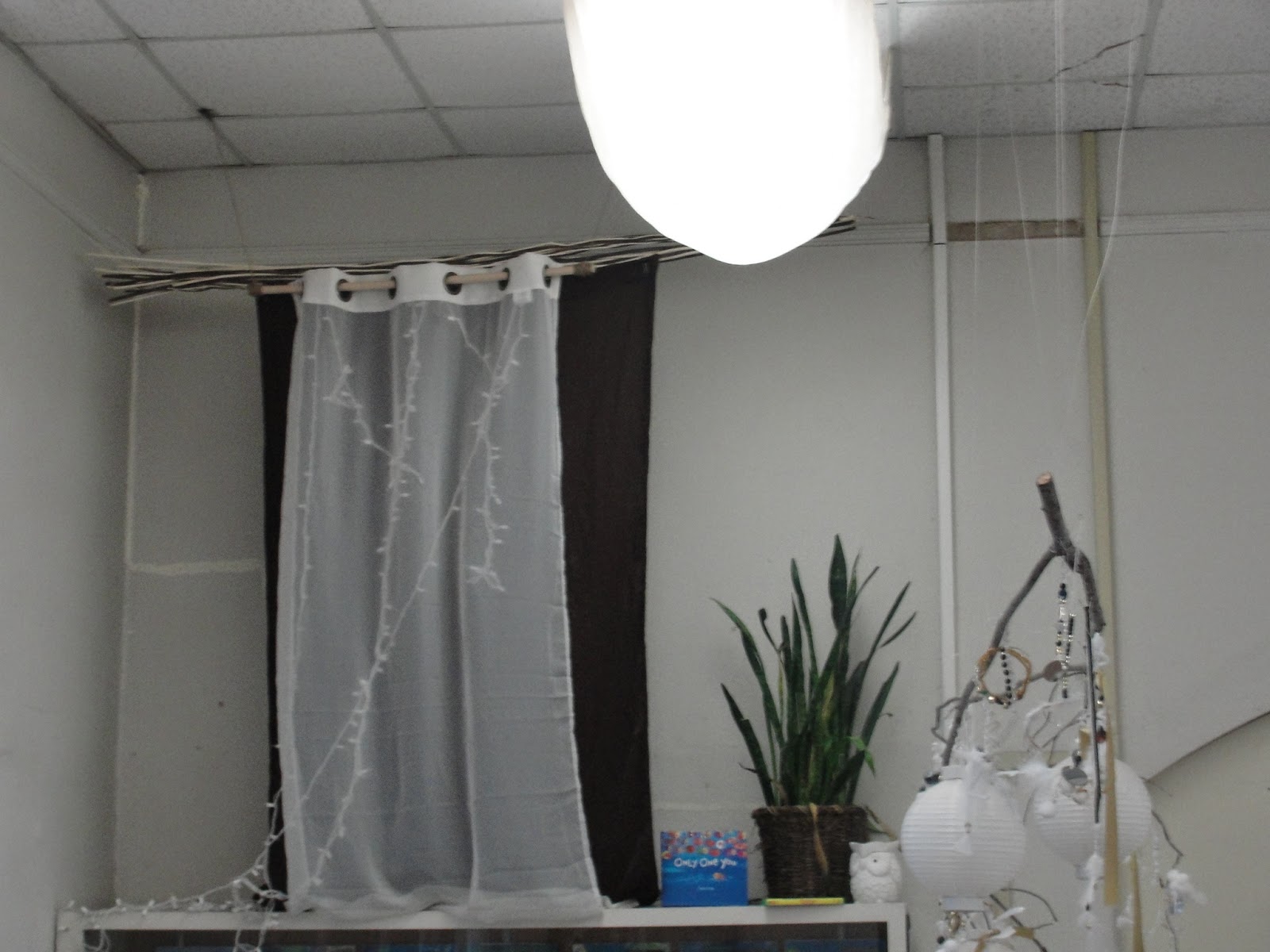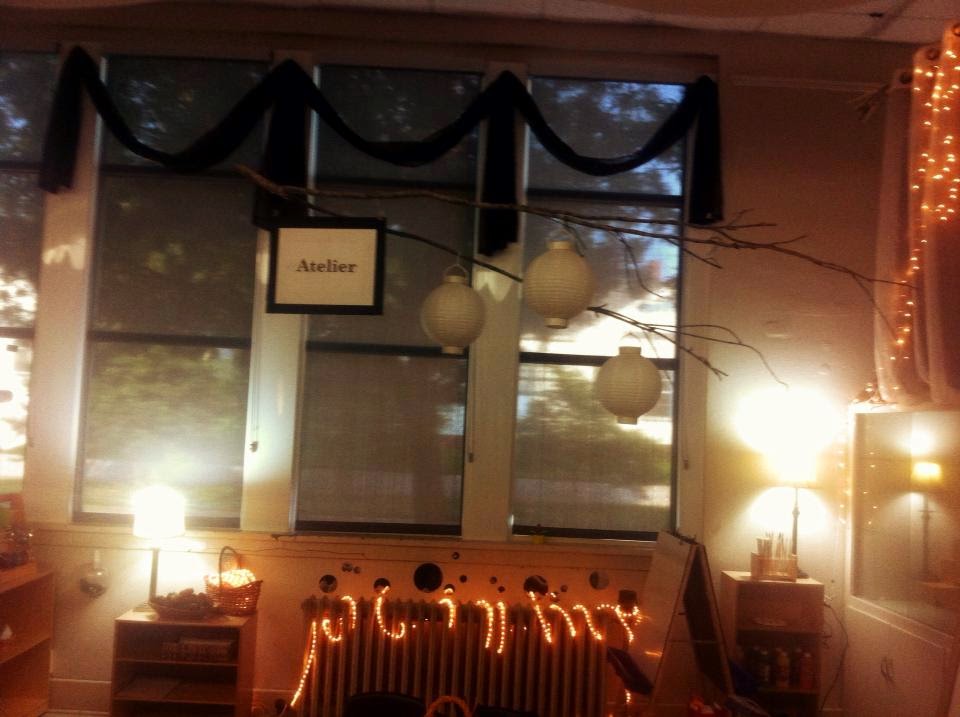Ms. Dean's Kindergarten Classroom
My philosophy is that the environment is the third teacher.
I often felt like the environment was one of the hardest to successfully construct. It was difficult trying to figure out how to put in all the elements and still have movement through my room. I began 10 years ago working on different room arrangements and styles. I fell in love with the Reggio Emilia philosophy of bringing natural and re-purposed materials into the environment. I have been on a quest ever since. I believe that I am always learning and growing in this area. I thought I would give out some of my successes over the years. I have already posted about the Princess and Dragon class for a multi-age 3-5 years old. I am going to show some elements from Ms. Deans class that I came in and consulted on her classroom. He room was a old classroom that was used for storage for years. She was hired after the school year started. She was left with a lot of furniture that was in disrepair or 50 years old.
Before Pictures:
Mrs. Dean was a first year teacher walking into a empty classroom for Kindergartners. She worked hard and was able to create an environment that was usable but did not inspire the children or her. The lack of materials and arrangement of the room became overwhelming.
Her professor called me and asked if I could work with a group of teachers to help create an environment that would inspire children.
This was one of my first experience creating an environment for another teacher.
Looking at her room we determined she needed different arrangement of centers to create better and efficient movement in her room.
The lighting was awful, we discussed different options that would best fit her style.
First step in arrangement and lighting is looking for electrical outlets. This is the most important for lighting and choosing where centers will be located and what type of lighting can be done in her room.
Second was location to sinks.
Third- Finding furniture, lights, and rugs.
Fourth- Finding Materials and containers
Fifth- Drawing out her room layout so that others could come in and help her put it together in one day.
After Pictures:
 We added draping over her fluorescent light. Arranged the room so that there was an openness for a better flow around her centers.
We added draping over her fluorescent light. Arranged the room so that there was an openness for a better flow around her centers.
She had some lights, drapes, and a lighted lantern. The drapes added definition to the space as well as adding gentler lighting.
The children was always worried about the repaired crack in the wall. We added layers of curtains with lights and added some plants to conceal the crack from view.
This was a great first project for me.The collaboration with a group of teachers was insightful because I was able to learn how other view environments.
Collaboration is a huge component to the process.
Ms. Dean was amazing to work with and all the other teachers that came together to help.
Ms. Dean was able to take the little bit of help that we gave her and took her environment to a whole new level. He environment this year is truly inspiring!
What a beautiful room!!
 I think that when you open the door to your classroom that it should be a welcoming environment for the teacher, parent, visitors, and students. This is one of the elements in a Reggio Inspired classroom that should be your first decision. How do you want it to look and what does it say. I want my parents to have a place to get information and feel that they are a part of our classroom. Since, I'm in a public school setting it is crucial that you have elements about objectives that you are meeting in the classroom. Parents and administrators know that I am prepared and put thought into what is planned. One of the drawbacks about following the Reggio Emilia philosophy is that many people are not knowledgeable about what the children are learning. They portray your environment, materials, centers, and lessons that the children are just playing, that the classroom is not structured, or it does not have enough rigor. To counteract that view, I have objectives on the wall for the parents and administrators to see as they walk in the room. Information is on the walls for the parents to read. Communication about what is happening in your room can make the difference in parents believing in what you are teaching their children. I am a big believer in quotes. I place them around the objectives so that parents can read what theorist in Early Childhood Education , famous artist, inventors, and scientist say about education. My objectives are made using frames (seen on pinterest). I placed stickers on the outside of the glass saying: Objectives of the Day, Math, Language Arts, Literacy, Social Studies, and Science. I write the common core statements with a sharpie on the glass. They are mounted to the wall with Command Stripes. I wipe the marker off with alcohol wipes.
I think that when you open the door to your classroom that it should be a welcoming environment for the teacher, parent, visitors, and students. This is one of the elements in a Reggio Inspired classroom that should be your first decision. How do you want it to look and what does it say. I want my parents to have a place to get information and feel that they are a part of our classroom. Since, I'm in a public school setting it is crucial that you have elements about objectives that you are meeting in the classroom. Parents and administrators know that I am prepared and put thought into what is planned. One of the drawbacks about following the Reggio Emilia philosophy is that many people are not knowledgeable about what the children are learning. They portray your environment, materials, centers, and lessons that the children are just playing, that the classroom is not structured, or it does not have enough rigor. To counteract that view, I have objectives on the wall for the parents and administrators to see as they walk in the room. Information is on the walls for the parents to read. Communication about what is happening in your room can make the difference in parents believing in what you are teaching their children. I am a big believer in quotes. I place them around the objectives so that parents can read what theorist in Early Childhood Education , famous artist, inventors, and scientist say about education. My objectives are made using frames (seen on pinterest). I placed stickers on the outside of the glass saying: Objectives of the Day, Math, Language Arts, Literacy, Social Studies, and Science. I write the common core statements with a sharpie on the glass. They are mounted to the wall with Command Stripes. I wipe the marker off with alcohol wipes.
































